Welcome to another Smut Clyde–guided tour through another fraud freak-show. The central character here is Benjamin Bonavida, cancer and apoptosis researcher, and recently retired distinguished professor at the David Geffen School of Medicine University of California Los Angeles (UCLA), the university where he studied in 1960ies and spent his entire career since. One special joke about Bonavida is that he managed to portray himself as an actual victim of two of his fraudulent lab members, who were sacked and shamed in public, their papers retracted. Neither Bonavida or his senior collaborators suffered any visible consequences, and there were some serious heavyweights involved, including the then-Vice Chancellor for Research at UCLA, James Economou. Another extra bit of irony is that while publishing fabricated research with Bonavida, that Vice Chancellor was actually in charge of research integrity at their common university. Bonavida’s other prominent coauthor is Demetrios Spandidos, once sacked in US for made-up data in his past life as scientist and reborn in Greece as owner of Spandidos Publications, which later expanded into the even more lucrative business of scamference conference organising.
Smut Clyde presents below a long list of fabricated papers signed by Bonavida, while this UCLA professor’s PubPeer record seems to grow daily, with currently over 30 papers covering the time period from 1999 till 2014. Basically, the Golden Age of molecular biology when Photoshop became the standard tool of data falsification while hardly any journal bothered to check. Yet Bonavida’s publication history goes as far back as 1967, long before myself or most of my readers were born. How did Dr Bonavida manufacture his research results back then? A question for science historians.
In an 2017 article in The Scientist, Bonavida was painted as an innocent victim of a criminal Japanese student. His story was equalled to that of Carlos Moraes from the University of Miami, who hosted the German postdoc Tina Wenz in his lab. Together Moraes and Wenz published six papers, all of which were later proven to be fraudulent and retracted. Wenz deployed lawyers, apparently against everyone including Moraes (even I received a threatening letter back then). At the end she was one of the rare German scientists publicly named and shamed by the DFG, and by her own University of Cologne (where she used to have a DFG-funded lab). It was namely Moraes who reported the data manipulations and demanded retractions of his own papers, against the pushback from Wenz’ elite law firm. Bonavida on the other hand tried to prevent journals from retracting his papers despite official verdicts, while his many other clearly fraudulent works on PubPeer have different co-authors.

You wait and wait for a bus to throw co-authors under, and then three come along at once. By Smut Clyde
There is a quality of entertaining schadenfreud Greek Tragedy about the spectacle of a UCLA Vice Chancellor for Research, and quondam Officer for Research Integrity, incurring the retraction of two research papers because of shenanigans in the data. And in the manner of Sophocles or Euripides, we enter the story in media res with much of the action having already occurred, to be visited in flashback or recounted by the chorus. There may be hubris, or the other tragic flaws of Greek dramaturgy. There will certainly be some Western blots, and perhaps some Northern blots for the sake of variety.
A flurry of papers from the UCLA cancer-research dynamo were retracted at about the same time; please pay attention, and try to keep them distinct in your minds, as there may be a quiz. Fortunately everything has been closely documented by the people at RetractionWatch, providing coroner’s reports for the demise of the papers after their persecution and assassination by anonymous post-publication commentary at PubPeer.
To begin in 2014, then, questions were raised about a publication from 2007… first in a dedicated blog, then echoed to PubPeer:
[1]. Eriko Suzuki, Kazuo Umezawa & Benjamin Bonavida
Rituximab inhibits the constitutively activated PI3K-Akt pathway in B-NHL cell lines: involvement in chemosensitization to drug-induced apoptosis
Oncogene 2007, doi: 10.1038/sj.onc.1210448 , PubPeer here).
First author Eriko Suzuki promptly shouldered the blame for defects in data quality which made the paper unsustainable (at the cost of her PhD and professional career), as verified by RetractionWatch. By “defects in data quality” I mean images of protein expression which were recycled for different conditions, and sometimes for different proteins:


 That dedicated blog had called into question a second paper. However, Suzuki was emphatic that her responsibility did not extend that far. And she did pointedly skipped the opportunity to apologise for a role in other collaborations from her time at UCLA.
That dedicated blog had called into question a second paper. However, Suzuki was emphatic that her responsibility did not extend that far. And she did pointedly skipped the opportunity to apologise for a role in other collaborations from her time at UCLA.
I declare that I am not in charge regarding inappropriate corrections in Int. J. Oncol. 2010.
The paper was prepared by Dr. Bonavida group after my study in UCLA.
So let’s just number that paper as [0] for the moment, and ignore it:
[0] Eriko Suzuki, Tracy R. Daniels, Gustavo Helguera, Manuel L. Penichet, Kazuo Umezawa, Benjamin Bonavida
Inhibition of NF-kappaB and Akt pathways by an antibody-avidin fusion protein sensitizes malignant B-cells to cisplatin-induced apoptosis
Int. J. Oncol. (Spandidos) 2007. doi: 10.3892/ijo_00000615
Anyway, there was evidently an investigation, as The Scientist reported:
“In UCLA’s ensuing investigation, Bonavida was cleared of wrongdoing; nevertheless, he says, he was left in shock. “It affected me very deeply,” he says. “I have trained over a hundred students through my career. Nobody has done something like that with my work before.”
Investigations did not stop there, and the end of 2016 saw two more retractions. Professor Bonavida was again the victim of a conspiracy of fate. Answering questions from Retraction Watch, he thought the university had acted too hastily:
“He said a committee at UCLA investigated the allegations, and although he was initially informed the committee was going to ask the journal to correct the papers,
“…for some reason, they went ahead with the retractions…without asking our opinion.”
… and that the concerns were misguided or malicious.
“Some of the gels that were represented for the controls, apparently somebody claims they were reproduced from other figures. That was not the case, but it was very hard to prove that…I could not defend it, but I tried very hard”.
Here are the two papers, both from the Journal of Immunology, a society journal which seems to be have acquiesced to being a victim of fraud trolling. Some of the authors are recurring members of the dramatis personae so I have boldfaced their names
[2]. Stavroula Baritaki, Alina Katsman, Devasis Chatterjee, Kam C. Yeung, Demetrios A. Spandidos and Benjamin Bonavida
Regulation of tumor cell sensitivity to TRAIL-induced apoptosis by the metastatic suppressor Raf kinase inhibitor protein via Yin Yang 1 inhibition and death receptor 5 up-regulation”
(Baritaki, Katsman, Chatterjee, Yeung, Spandidos, Bonavida 2007, PubPeer here)
[3]. “Inhibition of Yin Yang 1-dependent repressor activity of DR5 transcription and expression by the novel proteasome inhibitor NPI-0052 contributes to its TRAIL-enhanced apoptosis in cancer cells“
J Immunology (2008) doi: 10.4049/jimmunol.179.8.5441, PubPeer here).
The papers dip into a shared library of blots. It turns out that a single image can be rearranged to illustrate different ways of modulating cell death through the surface protein “Death Receptor 5”. Who knew that molecular biology had such Metal names?
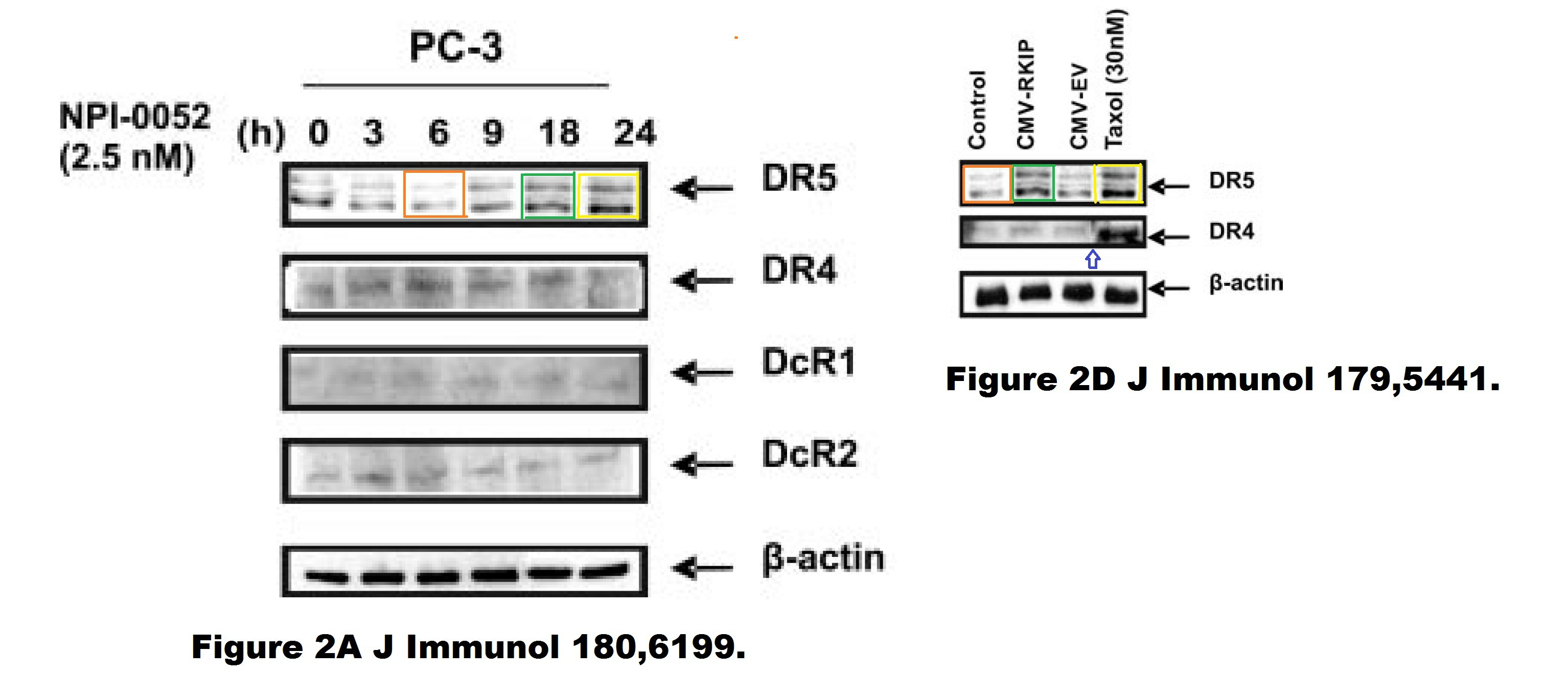
Neither of them redounds to the credit of the journal reviewers who looked at the Figures and thought “Yes, that’s what loading controls should look like” (or else “OK, that’s fake, but it’s only a loading control so who cares?”). Nor to the credit of the various authors who can’t have looked at the Figures at all. [3] in particular stands out by the lack of effort to hide the fabrications and manipulations.

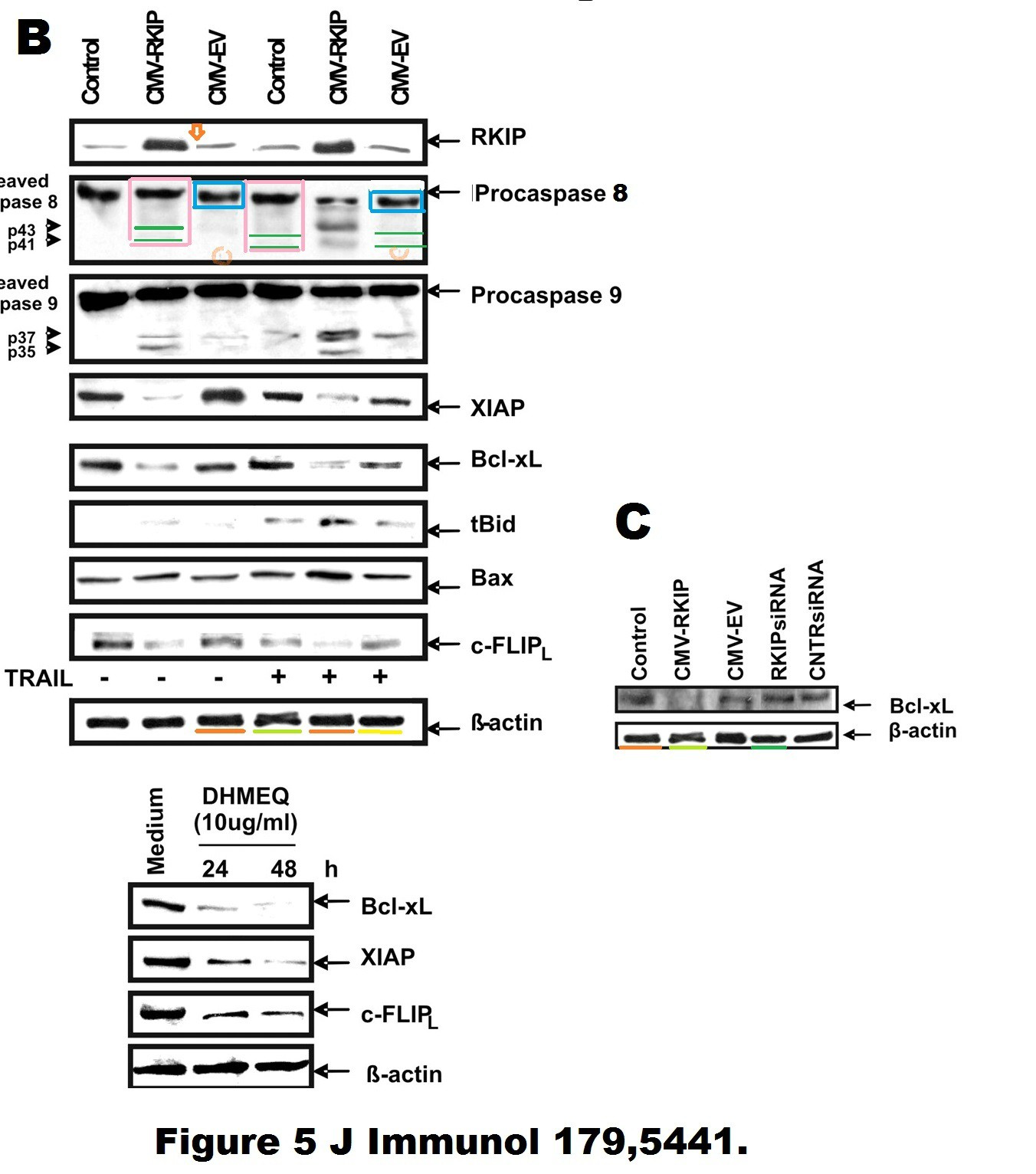
In its quieter way, [2] also warrants attention. One of its “jumping-gene” loading controls with the self-shuffling lanes (Fig 5C, here at bottom) made a later appearance in a further paper also under the aegis of PubPeer.
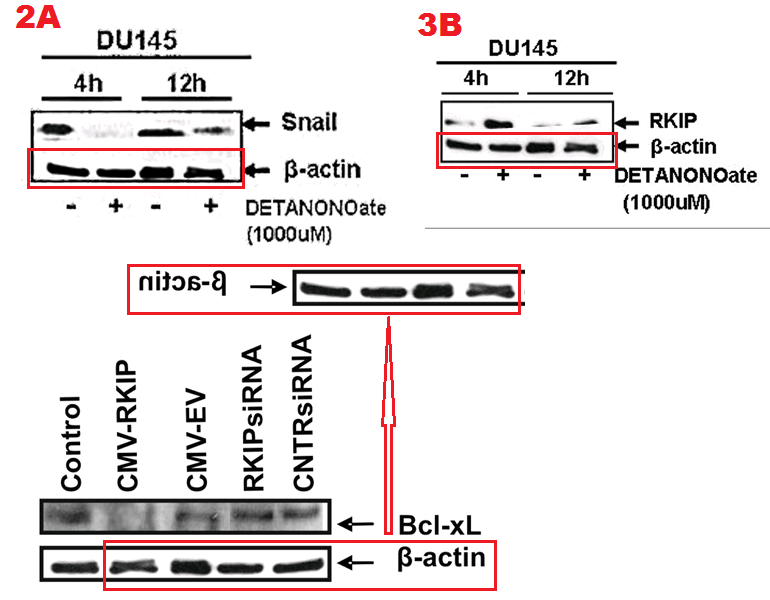
But I am getting ahead of myself. First we should meet papers
[4] Ali R. Jazirehi, Stavroula Baritaki, Richard C. Koya, Benjamin Bonavida and James S. Economou
Molecular Mechanism of MART-1+/A*0201+ Human Melanoma Resistance to Specific CTL-Killing Despite Functional Tumor–CTL Interaction
Cancer Research (2011), doi: 10.1158/0008-5472.CAN-10-1296, PubPeer here);
and
[5] Ali R. Jazirehi and James S. Economou
Proteasome Inhibition Blocks NF-κB and ERK1/2 Pathways, Restores Antigen Expression, and Sensitizes Resistant Human Melanoma to TCR-Engineered CTLs
Mol Cancer Ther. (2012), doi: 10.1158/1535-7163.MCT-11-0814, PubPeer here).

They joined the flurry of retractions in early 2017, on the request of the senior author. Professor Economou wore many hats at UCLA, being head of his own cancer-research lab there, Chief of Surgical Oncology, Vice Chancellor for Research, and Officer for Research Integrity. He did not respond to overtures from RW. Prof. Bonavida was a co-author on [4], and he was more forthcoming with comments, though his response was to downplay his auctorial role:
“Bonavida told Retraction Watch that his involvement in the Cancer Research paper was only as a “consultant” who looked it over before it was submitted:
“All the work was done in Economou’s lab, not mine. I have no idea what exactly took place.
The original findings, they were all prepared by Ali Jazirehi.”
Bonavida added that he knew Jazirehi well, as Jazirehi had worked in his lab “many years” before.”
Given Bonavida’s confident conviction that there were no more shoes left to drop, readers who are familiar with all literary conventions will be wondering about the size of the iceberg of problematic papers for which these five are the tip. By way of answer, let these performing planaria entertain you with their well-rehearsed wriggling routine, as choreographed and trained by Jim McConnell for a special issue of the Worm Runner’s Digest.

Alternatively, they are part of a Western Blot loading control, appearing in three different contexts in a little triptych of problematic papers:
[6] S Baritaki, K Yeung, M Palladino, J Berenson and B Bonavida
Pivotal roles of snail inhibition and RKIP induction by the proteasome inhibitor NPI-0052 in tumor cell chemoimmunosensitization
Cancer Res. (2009), doi: 10.1158/0008-5472.CAN-09-1069, PubPeer here);
[7] S Baritaki, A Chapman, K Yeung, D A Spandidos, M Palladino & B Bonavida
“Inhibition of epithelial to mesenchymal transition in metastatic prostate cancer cells by the novel proteasome inhibitor, NPI-0052: pivotal roles of Snail repression and RKIP induction“
Oncogene (2009), doi:10.1038/onc.2009.214, PubPeer here); and
[8] S Baritaki, S Huerta-Yepez, A Sahakyan, I Karagiannides, K Bakirtzi, A Jazirehi & B Bonavida
Mechanisms of nitric oxide-mediated inhibition of EMT in cancer: inhibition of the metastasis-inducer Snail and induction of the metastasis-suppressor RKIP
Cell Cycle (2010), doi: 10.4161/cc.9.24.14229, PubPeer here).

A number of shared and relabelled visual elements interlink the triptych (while as was foreshadowed above, [8] and [2] have an element in common). Most notably, some blots of antibody-labelled protein are versatile in their roles, illustrating the presence of “Snail”, XIAP, Fibronectin or β-actin.
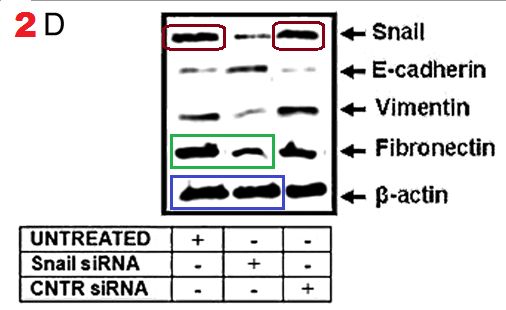

As we strip-mine into deeper strata of the PubPeer archive, eventually we reach another nexus of interlinked papers, though this one is more of a Pentateuch. Two of its members are closely entwined:
[9] A Jazirehi, M Vega, D Chatterjee, L Goodglick & B Bonavida
Inhibition of the Raf–MEK1/2–ERK1/2 Signaling Pathway, Bcl-xLDown-Regulation, and Chemosensitization of Non-Hodgkin’s Lymphoma B Cells by Rituximab“
Cancer Res. (2004), DOI: 10.1158/0008-5472.CAN-03-3500 , PubPeer here), and
[10] A Jazirehi, S Huerta-Yepez, G Cheng & B Bonavida
Rituximab (chimeric anti-CD20 monoclonal antibody) inhibits the constitutive nuclear factor-κB signaling pathway in non-Hodgkin’s lymphoma B-cell lines: role in sensitization to chemotherapeutic drug-induced apoptosis
Cancer Res. 2005, PubPeer here.
Loading controls are recycled to an impressive extent,


So many protein bands are using multiple alias that one’s attempts to keep track of them run quickly out of colors.
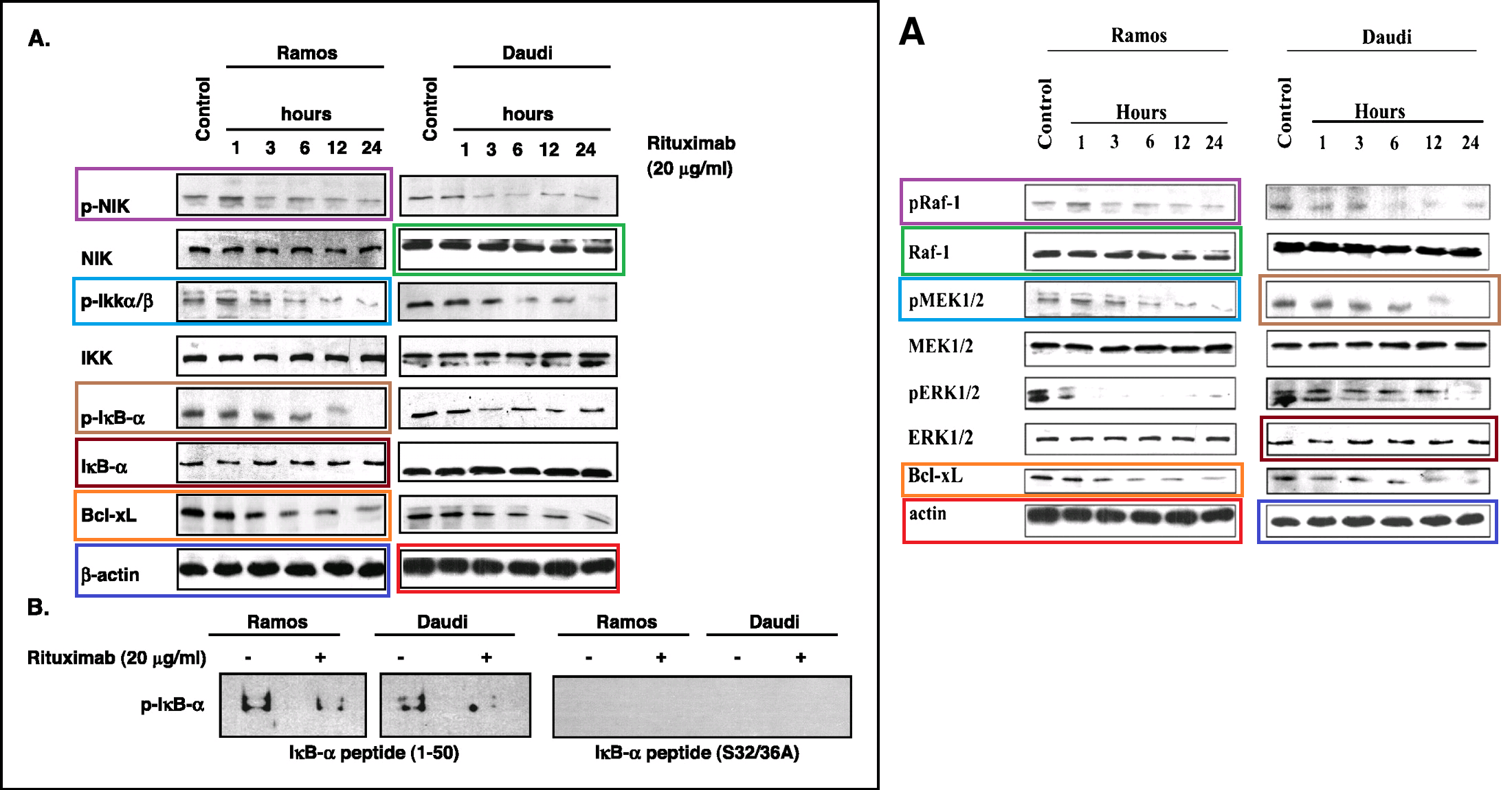
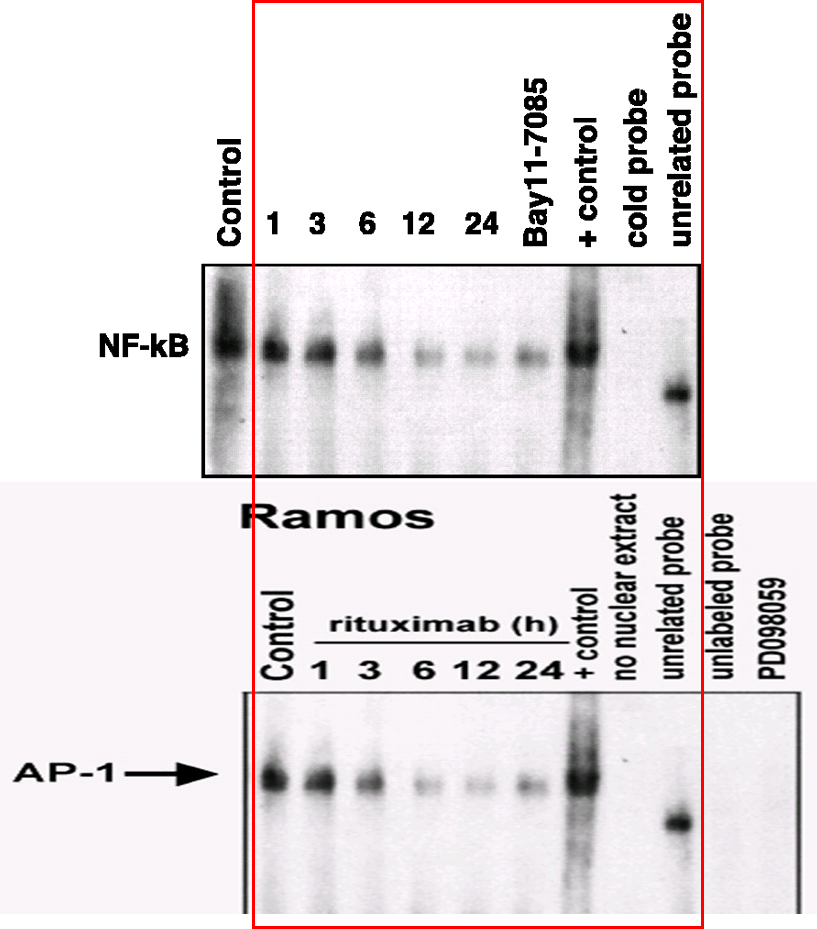
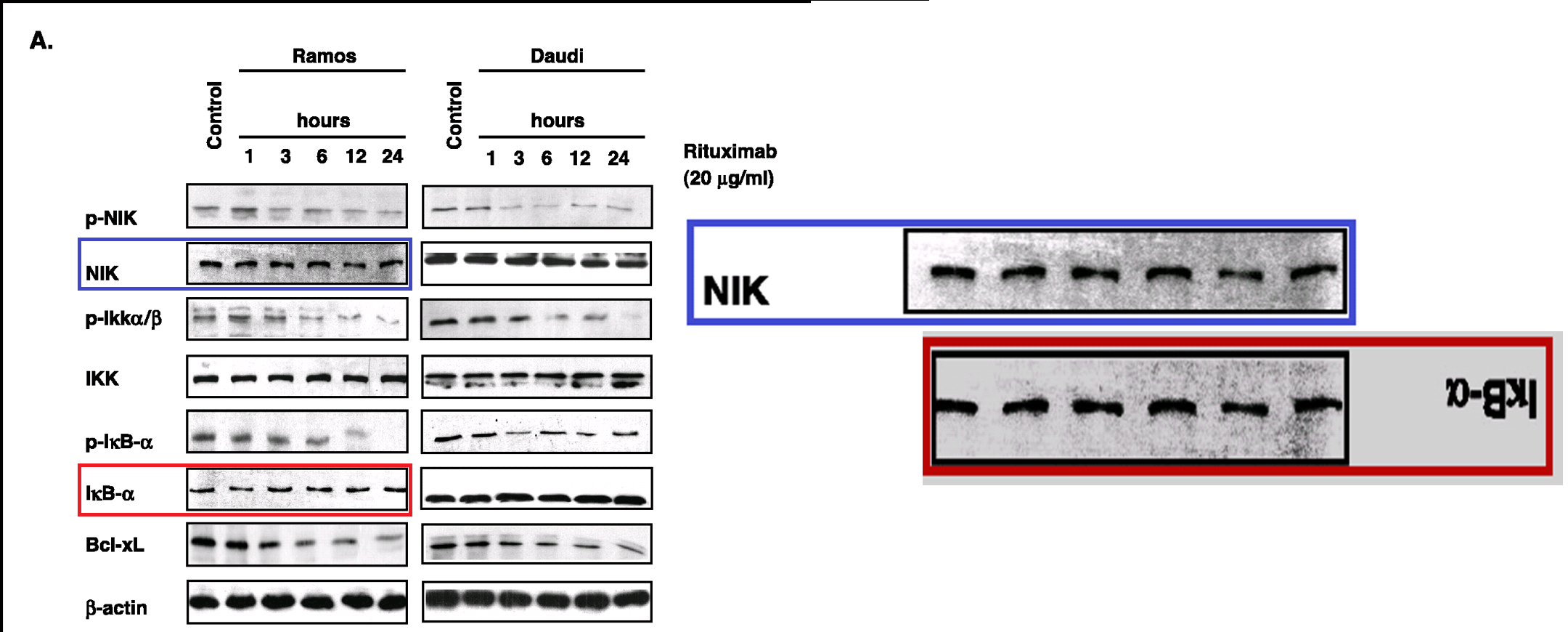
One of those protein band, identified with brown boxes above as IκB and ERK1/2 (and, after a 180° flip and some tweaks, as NIK) underwent further vicissitudes. It appeared as IκB again in
[11] M Vega, A Jazirehi, S Huerta-Yepez & B Bonavida
Rituximab-Induced Inhibition of YY1 and Bcl-xL Expression in Ramos Non-Hodgkin’s Lymphoma Cell Line via Inhibition of NF- B Activity: Role of YY1 and Bcl-xL in Fas Resistance and Chemoresistance, Respectively
J Immunol. (2005), doi: 10.4049/jimmunol.175.4.2174 , PubPeer here); and in its rotated manifestation, as ERK1/2 in
[12] A Jazirehi & B Bonavida
Resveratrol modifies the expression of apoptotic regulatory proteins and sensitizes non-Hodgkin’s lymphoma and multiple myeloma cell lines to paclitaxel-induced apoptosis“
Mol. Cancer Ther. (2004), PubPeer here).


Papers in this series are also linked by their use of protein-expression RNA immunoblots (reverse-transcriptase / PCR), providing us with some relief from the barrage of Western Blots. For close inspection reveals many more images of RNA blots than there are underlying data, with some creative re-use linking [9] and [10]…
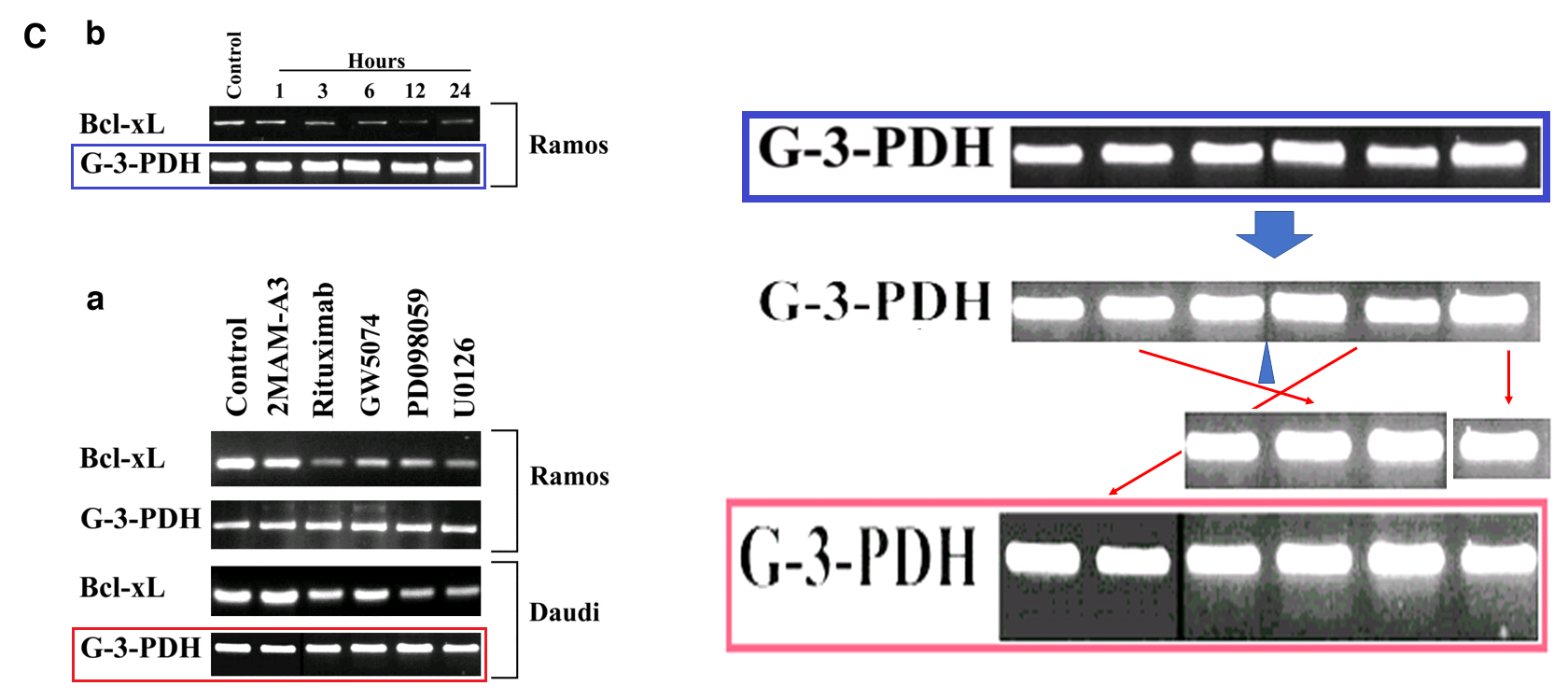

…with the lanes further jiggered and poked to integrate [12] into the mesh as well.

The ‘Rituximab’ of the titles is not a Mayan temple complex in the Yucatan Peninsula, but rather a monoclonal antibody designed to destroy unwanted B-lymphocytes; evidently its apoptosis-pathway actions were attracting research interest in the early 2000s. Quite how the results found their way into [12] is an interesting question, as Resveratrol has nothing to do with Rituximab except a shared initial letter (and being another popular research topic of the era). Anyway, this leads us to:
[13] A Jazirehi, XH Gan, S De Vos, C Emmanouilides & B Bonavida
Rituximab (anti-CD20) selectively modifies Bcl-xL and apoptosis protease activating factor-1 (Apaf-1) expression and sensitizes human non-Hodgkin’s lymphoma B cell lines to paclitaxel-induced apoptosis
Mol Cancer Ther. (2003), PubPeer here)
It was first in this nexus to be published, and its contents were plundered to provide illustrations for [10] and [12]. The latter reuse required a 180° flip of the Actin loading band as well as the confusion between Rituximab and Resveratrol.


From the same epoch we find
[14] M Vega, S Huerta-Yepaz, H Garban, A Jazirehi, C Emmanouilides & B Bonavida
Rituximab inhibits p38 MAPK activity in 2F7 B NHL and decreases IL-10 transcription: pivotal role of p38 MAPK in drug resistance
Oncogene (2004), doi: 10.1038/sj.onc.1207336, PubPeer here).
This was a one-off paper, with no pictorial links to other papers, only internal connections… the proteins P-p38 and Bcl-2 proved to be the same, or at least they provided identical bands of immunohistochem gel. A display of RNA expression for a particular protein was dismantled like a Lego tower and reassembled for a different protein.
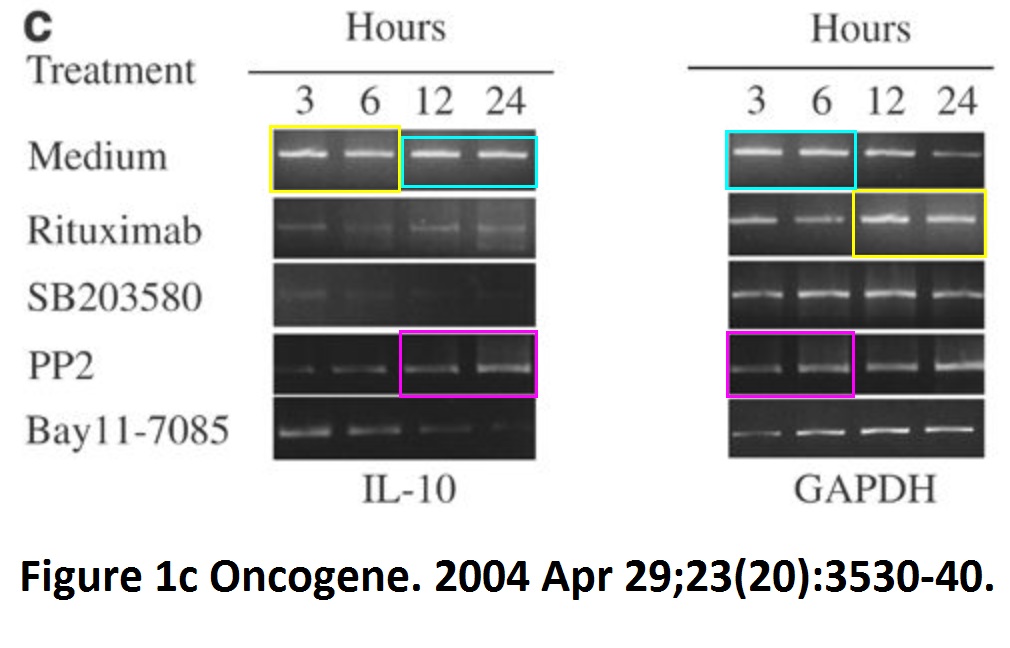
And [15] A Jazirehi, M Vega & B Bonavida
Development of rituximab-resistant lymphoma clones with altered cell signaling and cross-resistance to chemotherapy
Cancer Res. (2007), doi: 10.1158/0008-5472.CAN-06-2184 , PubPeer here).
The duplications are blatant, placed side-by-side as if daring the reviewers to do something about it. Dr. Stavroula Baritaki is thanked “for technical assistance”.


The PubPeer archive reveals a few other free-standing papers. Despite the pressure of space I cannot bring myself to omit
[16] S Baritaki, S Huerta-Yepez, T Sakai, D Spandidos & B Bonavida
Chemotherapeutic drugs sensitize cancer cells to TRAIL-mediated apoptosis: up-regulation of DR5 and inhibition of Yin Yang 1
Mol Cancer Ther. (2007), doi: 10.1158/1535-7163.MCT-06-0521, PubPeer here).
We are accustomed to yeoman service from loading controls, overlapped and recycled as in Figures 3 and 4, but in an innovative step, the substantive protein strips of Fig. 3 were sliced horizontally to become the substantive strips of Fig. 4 – DR5 becoming YY1.


 #7 Peer 4 commented 2 years ago
#7 Peer 4 commented 2 years ago
Unbelivable science. Mol Cancer Ther should be listed as an art journal,
specifically in the abstract art category.
After all this, when Bonavida insists that “Nobody has done something like [Suzuki’s short-cuts] with my work before”, we can only marvel at his capacity for constructive inattention.
One last case-study:
[17] Saad Yousuf, MeiLi Duan, Erika L. Moen, Sam Cross-Knorr, Kate Brilliant, Benjamin Bonavida, Theresa LaValle, Kam C. Yeung, Fahd Al-Mulla, Eugene Chin, Devasis Chatterjee
Raf kinase inhibitor protein (RKIP) blocks signal transducer and activator of transcription 3 (STAT3) activation in breast and prostate cancer
PLoS ONE (2014), doi: 10.1371/journal.pone.0092478, PubPeer here.

With Bonavida as only a minor contributor, that paper is peripheral to my topic here; I cite it more for the third appearance of Devasis Chatterjee, here as senior author [see [2, 9] above]. Now Chatterjee has previously come up on the radar through his collaboration with Paul B Fisher of Virginia Commonwealth University, making the present post a sequel of sorts, or a prequel, or a continuity story to that earlier survey of cancer research at VCU.
Demetrios Spandidos was another co-author whose collaborations were regular enough to be singled out with boldface above [2, 3, 7, 16]. At the time of these papers he was affiliated to the University of Crete at Herakleion, but he is best-known as the publisher / editor of cancer-themed journals including International Journal of Oncology (see [0]), and as the entrepreneur of the inevitable cancer-themed conferences. His backstory is eventful, even chequered, stretching back three decades to his time as a postgrad student in Toronto when he was about to publish groundbreaking Nobel-worthy research into oncogenes until everything ended in expulsion from the Louis Siminovitch laboratory and tears before bedtime. But there is no space for that saga now so I will just refer you to primary sources.
From one perspective, all this is now of academic / historical interest. The people most central in all these questionable papers have left research (or left UCLA, which is the same thing!). Stavroula Baritaki still appears on UCLA staff lists but a recent conference (co-organisers: Baritaki & Bonavida) describes her as affiliated to the University of Crete. Bonavida has retired – from his laboratory, if not from conferencing – while Economou has stepped down from vice-chancelloring, closed his laboratory and returned to clinical work. As for Jazirehi, he is suing Economou and the Regents of UCLA for wrongful dismissal.
Now this does not prove that further inquiries did proceed in private, with data shenanigans identified and blamed on Jazirehi, though it is compatible with such a course of events. One can only be sure that whatever was determined. Jazirehi feels that he was singled out as a scapegoat.

Anyway, with these departures, one could argue that even if some of the results reported in [6] to [17] were just made up (with the forgery more egregious than anything in [1] to [5]), another inquiry and further retractions would achieve nothing except institutional embarrassment. Though they would free the PubPeer commentariat from the compulsion to go on documenting image misbehaviour.
This is supposed to be a happy occasion. Let’s not bicker and argue about who faked what!
There is also the possibility that despite the weakness of the evidence available to the authors, forcing one or several of them to fabricate more compelling and publishable results, the conclusions of those papers were actually correct, so additional retractions would be wrong.
I can only say that policies of drawing a discreet veil over academic malfeasance and sweeping scandals under the bus carpet have always worked so well in the past.

Donate!
If you are interested to support my work, you can leave here a small tip of $5. Or several of small tips, just increase the amount as you like (2x=€10; 5x=€25). Your generous patronage of my journalism will be most appreciated!
€5.00


recently retired distinguished professor at the David Geffen School of Medicine University of California Los Angeles (UCLA)
I am not sure if Dr Bonavida has retired from Professoring. All I saw was that he was closing his laboratory (or relinquishing it)..
So when the Uni. of Crete Meeting (on RKIP) claims in the advertising to have the UCLA imprimatur, this is not impossible.
LikeLike
Professors never retire, they become emeritus !
LikeLike
Not true – it depends on the rules at each particular university and legal conditions in each country.
Professors may become emeriti, but not necessarily. Being emeritus as opposed to retiree usually brings certain rights with it, like keeping your e-mail address, keeping your physical office, the right to teach, the right to services on campus (e.g. using the library), etc.
So it may be interesting to know whether somebody retired from a position OR retired and received emeritus status, because the latter could indicate a continuing formal affiliation with the institution. If a university wants to get rid of a fraudster, they will not “emeritize” that person if they can avoid it.
LikeLike
How seriously should one take this?
Exp Mol Med. 2015 Sep 25;47:e185. doi: 10.1038/emm.2015.70.
The biological complexity of RKIP signaling in human cancers.
Farooqi AA1, Li Y2, Sarkar FH2.
Author information
1
Laboratory for Translational Oncology and Personalized Medicine, Rashid Latif Medical College, Lahore, Pakistan.
2
Departments of Pathology and Oncology, Karmanos Cancer Institute, Wayne State University School of Medicine, Detroit, MI, USA.
http://retractiondatabase.org/RetractionSearch.aspx?AspxAutoDetectCookieSupport=1#?AspxAutoDetectCookieSupport%3d1%26auth%3dSarkar%252c%2bFazlul%2bH
LikeLike
A Review paper written by Fazlul Sarkar doesn’t prove that the RKIP pathway is a meaningless moey-wasting dead-end, but it does not reassure.
LikeLike
Jerusalem Post hoodwinked!
https://www.jpost.com/Blogs/Think-With-Me/At-Ben-Gurion-University-the-slogan-is-Lets-Get-Rid-of-Cancer-453173
LikeLike
https://www.icrfonline.org/chapter/ny/board-of-directors
Executive Committee Members
Benjamin Bonavida, Ph.D.
Brad Goldhar
Vera Finkelstein
Yashar Hirshaut, M.D.
LikeLike
INTERNATIONAL JOURNAL OF ONCOLOGY 32: 829-839, 2008 829
Potentiation of cytotoxicity by combination of imatinib
and chlorimipramine in glioma
AYHAN BILIR 1*, MINE ERGUVEN 2*, GULPERI OKTEM 3, AYSEGUL OZDEMIR 4,
ATILLA USLU 5
, ESIN AKTAS 6 and BENJAMIN BONAVIDA 7
1
Department of Histology and Embryology, Istanbul University, Istanbul Faculty of Medicine, Istanbul;
2Department of Biochemistry, Istanbul University, Faculty of Pharmacy, Istanbul; 3Department of Histology and
Embryology, Ege University School of Medicine, Izmir; 4Department of Neurosurgery, Bakirkoy Hospital for Psychiatric
and Neurological Diseases, Istanbul; 5Department of Physiology, Istanbul University, Istanbul Faculty of Medicine,
Istanbul; 6Department of Immunology, Istanbul University, Institute for Experimental Medicine (DETAE), Istanbul,
Turkey; 7Department of Microbiology, Immunology and Molecular Genetics, Jonsson Comprehensive
Cancer Center, University of California, Los Angeles, CA, USA
Received November 19, 2007; Accepted January 7, 2008.
Figures 5 and 6.
LikeLike
Clin Cancer Res. 1997 Jun;3(6):963-72.
Chemosensitization of human prostate carcinoma cell lines to anti-fas-mediated cytotoxicity and apoptosis.
Uslu R1, Borsellino N, Frost P, Gárban H, Ng CP, Mizutani Y, Belldegrun A, Bonavida B.
Author information
1
Department of Microbiology, Jonsson Comprehensive Cancer Center, UCLA School of Medicine, University of California at Los Angeles, Los Angeles, California 90095, USA.
Figure 1.
LikeLike
Pingback: When gel bands go marching in, by Elisabeth Bik – For Better Science
Pingback: Victims as perpetrators – For Better Science
Pingback: Spandidos and the Paper Mill – For Better Science
2021 retraction. Note: Benjamin Bonavida as co-author.
PLoS One. 2014 Mar 21;9(3):e92478. doi: 10.1371/journal.pone.0092478. eCollection 2014.
Raf kinase inhibitor protein (RKIP) blocks signal transducer and activator of transcription 3 (STAT3) activation in breast and prostate cancer
Saad Yousuf 1, MeiLi Duan 2, Erika L Moen 1, Sam Cross-Knorr 1, Kate Brilliant 1, Benjamin Bonavida 3, Theresa LaValle 4, Kam C Yeung 5, Fahd Al-Mulla 6, Eugene Chin 7, Devasis Chatterjee 1
Affiliations1Department of Medicine, Rhode Island Hospital and The Alpert Medical School of Brown University, Providence, Rhode Island, United States of America.2Department of Medicine, Rhode Island Hospital and The Alpert Medical School of Brown University, Providence, Rhode Island, United States of America; Department of Critical Care Medicine, Beijing Friendship Hospital, Capital Medical University, Beijing, China.3Department of Microbiology, Immunology and Molecular Genetics, University of California Los Angeles, Los Angeles, California, United States of America.4Kolltan Pharmaceuticals, Inc., New Haven, Connecticut, United States of America.5Department of Biochemistry and Cancer Biology, University of Toledo, College of Medicine, Toledo, Ohio, United States of America.6Department of Pathology, Faculty of Medicine, Kuwait University, Safat, Kuwait.7Department of Surgical Research, Rhode Island Hospital and The Alpert Medical School of Brown University, Providence, Rhode Island, United States of America.PMID: 24658061 PMCID: PMC3962420 DOI: 10.1371/journal.pone.0092478
Retraction: Raf Kinase Inhibitor Protein (RKIP) Blocks Signal Transducer and Activator of Transcription 3 (STAT3) Activation in Breast and Prostate Cancer (plos.org)
Following the publication of this article [1], concerns were raised regarding results presented in Figs 1, 2, and 4.
Specifically,
Vertical irregularities suggestive of splice lines were detected in the following panels:○. Fig 1D, RKIP panel, between lanes 2 and 3.○.
Fig 2A DU145 RKIP panel, between lanes 1 and 2, as well as between lanes 2 and 3.○. Fig 2A PC3 RKIP panel, between lanes 1 and 2, as well as between lanes 2 and 3.
In Fig 2D, the PC3 PARP panel appears similar to the first two lanes of the right (DU145) panel, despite representing results obtained from different cell lines.In Fig 4A, the following similarities were detected between lanes presented in the middle panel and lanes presented in the right panel:○.
The first two lanes of the middle pY705 STAT3 panel appear similar to the first two lanes of the right pY705 STAT 3 panel. However, the corresponding Actin panel results for these lanes do not appear to match.○.
Lanes 3 and 4 in the middle panel appear similar to lanes 7 and 8 in the middle panel respectively, despite being used to represent different experimental conditions.○.
The last lane of the middle pY705 STAT3 panel appears similar to the last lane of the right pY705 STAT3 panel, despite being used to represent different experimental conditions.
The authors have not provided the original images underlying the panels of concern.In light of the concerns affecting multiple figure panels that question the integrity of the data, the PLOS ONE Editors retract this article.ELM agreed with the retraction and apologises for the issues with the published article. BB did not agree with the retraction. SY, MD, SC-K, KB, TL, KCY, FA-M, EC, and DC either did not respond directly or could not be reached.
Reference1.Yousuf S, Duan M, Moen EL, Cross-Knorr S, Brilliant K, Bonavida B, et al. (2014) Raf Kinase Inhibitor Protein (RKIP) Blocks Signal Transducer and Activator of Transcription 3 (STAT3) Activation in Breast and Prostate Cancer. PLoS ONE 9(3): e92478. https://doi.org/10.1371/journal.pone.0092478 pmid:24658061
LikeLike
Not yet in in RW database:
http://retractiondatabase.org/RetractionSearch.aspx#?auth%3dBonavida%252c%2bBenjamin
LikeLike